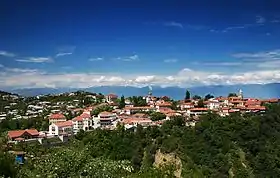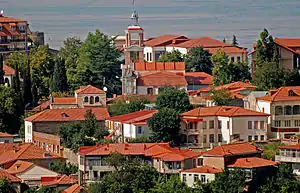Signagi
Signagi or Sighnaghi (Georgian: სიღნაღი) is a town in Georgia's easternmost region of Kakheti and the administrative center of the Signagi Municipality. Although it is one of Georgia's smallest towns,[4] Signagi serves as a popular tourist destination due to its location at the heart of Georgia's wine-growing regions, as well as its picturesque landscapes, pastel houses and narrow, cobblestone streets. Located on a steep hill, Signagi overlooks the vast Alazani Valley, with the Caucasus Mountains visible at a distance.
Signagi
სიღნაღი | |
|---|---|
 Signagi as seen from a nearby hill | |
 Signagi Location in Georgia  Signagi Signagi (Kakheti) | |
| Coordinates: 41°36′55″N 45°54′46″E | |
| Country | |
| Province | Kakheti |
| Area | |
| • Total | 2.978 km2 (1.150 sq mi) |
| Elevation | 836 m (2,743 ft) |
| Lowest elevation | 720 m (2,360 ft) |
| Population (2014) | |
| • Total | 1,485[1] |
| • Estimate (2019) | 1,565[2] |
| Time zone | EET |
| • Summer (DST) | UTC+4 (EEST) |
| Postal code | 4200 |
| Area code(s) | +995 99 |
| Website | www.signagi.com.ge |
| [3] | |
Etymology
The name of the town comes from Old Turkic word of syghynak (Turkish: sığınak, Azerbaijani: sığınacaq), meaning "shelter" or "asylum".[5]
History
Signagi is located in the Kakheti region of Georgia, first settled in the Paleolithic period. Throughout its history Signagi or Sighnaghi was known to the local population as Kambechovani, and later as Kisikhi or Kisiki. The word Sighnaghi in the Turkic language means shelter or trench. Signagi as a settlement was first recorded in the early 18th century. In 1762, King Heraclius II of Georgia sponsored the construction of the town and erected a fortress to defend the area from marauding attacks by Dagestani tribesmen.
According to the 1770 census, 100 families, chiefly craftsmen and merchants, lived in Signagi. When Georgia was annexed by Imperial Russia in 1801, Signagi (Signakh) was officially granted town status and became a centre of the Signakh uyezd (Russian: Сигнахский уезд) within the Tiflis Governorate in 1802. In 1812, Signakh joined the rebellion with the rest of Kakheti against Russian rule. During the Caucasian War, the town "was considered an important point on account of its proximity to" Dagestan.[6]
The town quickly grew in size and population and became an agricultural center in the Soviet Union. The severe economic crisis in post-Soviet Georgia heavily affected the town, but a major reconstruction project recently launched by the Government of Georgia and co-funded by several international organizations intends to both address an increasing tourist interest and modernize infrastructure.[7]
Geography and climate
The town has an area of 2.978 km² with 24.3% being residential.[7] Signagi is approximately 113 km southeast of Tbilisi, the capital of Georgia. Signagi District is adjacent, on the town’s east and southwest sides. Signagi is situated in the eastern foothills of the Gombori Range, a watershed between the Iori and Alazani valleys, in a productive agricultural and fruit-growing region. At the elevation of about 790 m above sea level, the town overlooks the Alazani Valley and faces the Greater Caucasus mountains.
Signagi has a mild Mediterranean-like climate. There are four seasons, with winters being moderately cold while summers can be hot. The highest average temperature is in July at 24.3°C while the lowest average temperature is in January at 0.2°C. Average annual precipitation ranges from 602.1 to 949.7 mm,[7] with the heaviest occurring during the spring months and early summer.
Culture and attractions
Signagi and its environs are home to several historical and cultural monuments and has been specifically protected by the State since 1975. The town is walled with the remnants of 18th-century fortifications. There are two Georgian Orthodox churches in the town itself - one dedicated to St. George and the other to St. Stephen. The venerated Bodbe Monastery is located 2 kilometers from Signagi and is a place of pilgrimage due to its association with St. Nino, the 4th-century apostle of Georgia.
The local Ethnographic and Archaeological Museum dating from the 1950s was upgraded and developed into a modern-standard exhibition the – Signagi Museum – in 2007.[8] Signagi is known as the "City of Love" in Georgia, with many couples visiting it just to get married.[9]
 The center of Signagi
The center of Signagi A street in Signagi, overlooking the Alazani Valley
A street in Signagi, overlooking the Alazani Valley Bodbe Monastery near Signagi where the remains of St. Nino are enshrined.
Bodbe Monastery near Signagi where the remains of St. Nino are enshrined. Signagi city walls
Signagi city walls
Notable people
- Otar Chiladze, writer
- Tamaz Chiladze, writer
See also
References
- "მოსახლეობის საყოველთაო აღწერა 2014". საქართველოს სტატისტიკის ეროვნული სამსახური. ნოემბერი 2014. Retrieved 7 ნოემბერი, 2016. Check date values in:
|accessdate=and|date=(help) - https://www.geostat.ge/en/modules/categories/41/population
- "Signagi (Abashis Raioni, Georgia)". Retrieved 2011-03-08.
- (in Georgian) The 2002 Census results Archived 2007-11-24 at the Wayback Machine, p. 47 (PDF format). The Statistics Department of Georgia. Retrieved on April 1, 2007.
- Beradze, G. G.; Smirnova, L. P. (1988). Материалы по истории ирано-грузинских взаимоотношений в начале XVII века (in Russian). Tbilisi: Мецниереба. p. 83.
Часто встречающееся в персидских источниках тюркское слово cикнак (сигнак) означает укрепленное место, укрытие, крепостное защитное сооружение. В отмеченном значении данное тюркское слово вошло и в другие языки, в том числе грузинский [238, с. 1091]. Нашло оно отражение и в грузинской топонимии, в частности в названии кахетинского города Сигнахи (ныне центр Сигнахского района Груз. ССР), возникшего во второй половине XVIII в. на месте былого укрепления…
- Van Halen, Don Juan (1828). Narrative of Don Juan Van Halen's Imprisonment in the Dungeons of the Inquisition at Madrid: And His Escape in 1817 and 1818. New York: J & J Harper. p. 269.
kahetia 1812.
- The official website of Signagi Archived 2007-09-28 at the Wayback Machine. Retrieved on April 1, 2007.
- Signagi Museum Archived 2011-07-21 at the Wayback Machine. Georgian National Museum. Retrieved on December 14, 2007.
- "Sighnaghi, Georgia". Advantour.
- Rosen, Roger. Georgia: A Sovereign Country of the Caucasus. Odyssey Publications: Hong Kong, 1999. ISBN 962-217-748-4
External links
| Wikimedia Commons has media related to Sighnaghi. |
- Promotional website of Signagi, State Department of Tourism and Resorts of Georgia, 2008.
- Government Looks to Make Signaghi a Top Tourist Destination. Georgian Business Week. June 4, 2007. Retrieved from The SME Support Project website, December 15, 2007.
![]() Signagi travel guide from Wikivoyage
Signagi travel guide from Wikivoyage

